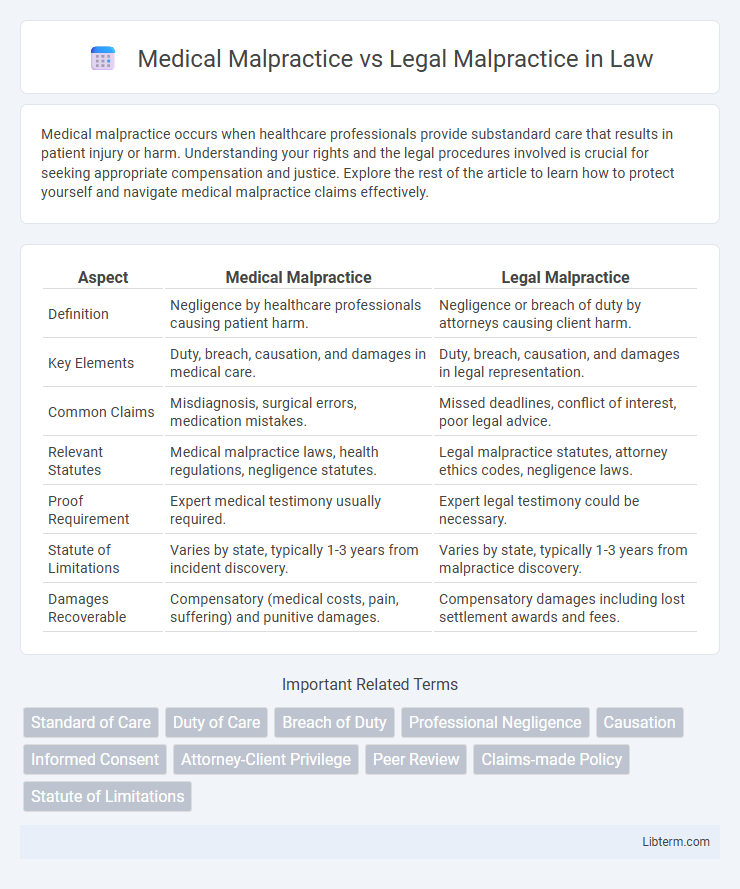Medical malpractice occurs when healthcare professionals provide substandard care that results in patient injury or harm. Understanding your rights and the legal procedures involved is crucial for seeking appropriate compensation and justice. Explore the rest of the article to learn how to protect yourself and navigate medical malpractice claims effectively.
Table of Comparison
| Aspect | Medical Malpractice | Legal Malpractice |
|---|---|---|
| Definition | Negligence by healthcare professionals causing patient harm. | Negligence or breach of duty by attorneys causing client harm. |
| Key Elements | Duty, breach, causation, and damages in medical care. | Duty, breach, causation, and damages in legal representation. |
| Common Claims | Misdiagnosis, surgical errors, medication mistakes. | Missed deadlines, conflict of interest, poor legal advice. |
| Relevant Statutes | Medical malpractice laws, health regulations, negligence statutes. | Legal malpractice statutes, attorney ethics codes, negligence laws. |
| Proof Requirement | Expert medical testimony usually required. | Expert legal testimony could be necessary. |
| Statute of Limitations | Varies by state, typically 1-3 years from incident discovery. | Varies by state, typically 1-3 years from malpractice discovery. |
| Damages Recoverable | Compensatory (medical costs, pain, suffering) and punitive damages. | Compensatory damages including lost settlement awards and fees. |
Understanding Medical Malpractice
Medical malpractice occurs when a healthcare professional deviates from the accepted standard of care, causing harm or injury to a patient. This form of negligence can involve misdiagnosis, surgical errors, medication mistakes, or failure to obtain informed consent. Understanding medical malpractice requires recognizing its impact on patient safety, legal liability, and the importance of expert testimony in establishing negligence.
Defining Legal Malpractice
Legal malpractice occurs when an attorney fails to provide competent representation, breaching the standard of care owed to a client and causing harm or financial loss. It includes errors such as missed deadlines, conflicts of interest, or inadequate investigation affecting the outcome of a case. Unlike medical malpractice, which involves negligence by healthcare professionals, legal malpractice specifically pertains to misconduct or negligence within the legal profession.
Key Differences Between Medical and Legal Malpractice
Medical malpractice involves negligence or errors by healthcare professionals causing patient harm, while legal malpractice refers to attorney negligence affecting client outcomes. Key differences include the nature of duty--medical professionals owe a duty of care for patient health, whereas lawyers owe fiduciary duty to protect clients' legal interests. Statutes of limitation, standard of care, and required expert testimony vary significantly between medical and legal malpractice claims.
Common Causes of Medical Malpractice
Common causes of medical malpractice include misdiagnosis, surgical errors, medication mistakes, and failure to obtain informed consent. Negligence in adhering to standard medical protocols and inadequate patient monitoring frequently result in harm. These errors often lead to prolonged illness, injury, or wrongful death, highlighting the critical importance of maintaining high standards of care in medical practice.
Typical Scenarios Leading to Legal Malpractice
Typical scenarios leading to legal malpractice include missed deadlines, inadequate client communication, conflicts of interest, and failure to follow client instructions. Errors such as improper case strategy, incorrect legal advice, or neglecting to file key documents also commonly result in claims. These issues contrast with medical malpractice, which involves errors in patient care or diagnosis rather than legal representation lapses.
Legal Standards for Proving Malpractice
Legal malpractice requires proving the attorney owed a duty of care, breached that duty through negligence or misconduct, and directly caused measurable harm or financial loss to the client. Medical malpractice involves demonstrating that a healthcare provider deviated from accepted medical standards, resulting in injury or damages. Both require expert testimony to establish the applicable standard of care and causation specific to professional fields.
Impact of Malpractice on Clients and Patients
Medical malpractice directly affects patients by causing physical harm, additional medical expenses, and emotional distress, often resulting in prolonged recovery or permanent injury. Legal malpractice impacts clients by potentially compromising the outcome of their cases, leading to financial losses, denial of justice, or extended legal battles. Both forms of malpractice erode trust, increase stress, and necessitate corrective actions such as litigation or compensation claims.
Compensation and Damages in Malpractice Cases
Medical malpractice compensation primarily covers damages related to physical injuries, emotional distress, and financial losses due to substandard healthcare, including medical bills, lost wages, and pain and suffering. Legal malpractice damages focus on financial harm caused by attorney negligence, such as lost settlements, additional legal fees, and damage to client reputation or case outcomes. Both types of malpractice cases often require demonstrating breach of duty and causation, but medical malpractice claims can involve more complex calculations related to long-term care and rehabilitation costs.
Preventing Medical and Legal Malpractice
Preventing medical malpractice requires rigorous adherence to clinical guidelines, thorough patient documentation, and ongoing professional education to minimize errors and enhance patient safety. Legal malpractice prevention hinges on clear client communication, diligent case management, and strict compliance with ethical and procedural standards to avoid negligence claims. Both fields benefit from risk management programs and continuous quality improvement initiatives to reduce liability and protect professional reputation.
Choosing the Right Attorney for Malpractice Claims
Selecting the right attorney for medical malpractice or legal malpractice claims requires expertise specific to each field, as medical malpractice involves complex healthcare standards while legal malpractice centers on breaches of professional duty by attorneys. Attorneys specializing in medical malpractice cases possess deep knowledge of medical terminology, hospital protocols, and expert witness coordination, ensuring strong case evaluation and litigation strategy. For legal malpractice claims, an attorney with a background in legal ethics, court procedures, and malpractice statutes is crucial to effectively assess negligence and seek appropriate damages.
Medical Malpractice Infographic

 libterm.com
libterm.com